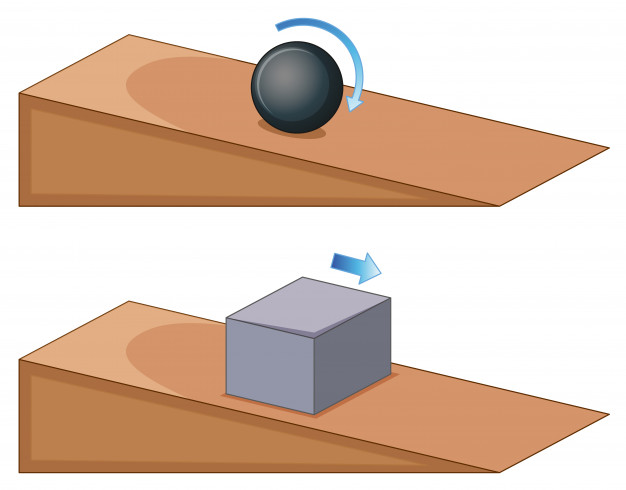The concept of balanced force can be easily understood, as it occurs in many aspects of daily life. All the objects that surround us, and that are stationary on the ground (a table, a piece of furniture, a parked car) are in balance force.
We can therefore define the concept of balanced force by stating that a body is in balanced force when it is stationary and continues to remain stationary.
Examples of balanced forces acting on an object:
Pool balls that are balanced being stuck.
Lifting Weights.
A car at rest being struck by another car.
The material point

To study the balancing force of bodies, let’s start with the simplest case; we consider a very small body compared to the surrounding environment, such that it can be considered as a point. For this, we will refer to the object by speaking of a material point.
For example, a ball rolling on the floor can be considered a material point.
The rigid body
In the case of everyday objects, however, it is not always convenient to use the concept of a material point. The object is therefore considered as if it were a rigid body, that is, it does not undergo any deformation whatever the forces applied to it.
Even the rigid body is a model, as there are no completely non-deformable bodies; however, many objects are non-deformable if less intense forces are applied to them.
The constraining forces
The balancing force of bodies is particularly influenced by constraints, that is, by objects that prevent the object under examination from making certain movements in space. For example, a picture hanging on the wall is bound by the nail in the wall, because without it it would fall to the ground; the train traveling on the tracks is bound by them because it is forced to follow that trajectory.
These constraints can exert forces on bodies; in this case, the forces are called constraining reactions (or forces). A constraining reaction opposes our weight strength, allowing us to stay balance forced and not fall. The floor, therefore, acts as a constraint, and the constraint reaction has the same intensity as the weight force, in the same direction, but the opposite direction.
Force-weight and ground binding reaction on a stationary person
The forces exerted on the body have the same intensity, the same direction, but the opposite direction; by the properties of the vector sum, the resultant of the forces is zero, and consequently, the body remains in equilibrium. In general, therefore, a material point remains in equilibrium if the resultant of the forces acting on it is zero; otherwise, if the result is non-zero, the point is not in equilibrium.
The inclined plane
An object can be in equilibrium even if it is on an inclined plane; the weight force acting on the body is exerted both by pushing the body along the plane and by keeping it pressed to the surface.
For this, it is convenient to decompose the weight force into its components, which we call the parallel component ($ F _ (//) $) and the perpendicular component ($ F_⊥ $).
The constraining force ($ F_V $) has a direction perpendicular to the inclined plane, and towards the outside of it; the perpendicular component, which is precisely perpendicular to the plane, has the same intensity as the constraining force, the same direction, and opposite direction.
The parallel component, on the other hand, is parallel to the plane, and facing downwards; to keep a material point in equilibrium on the inclined plane, therefore, it is necessary the presence of a force that cancels the parallel component; it must be parallel to the plane, and must have the same intensity and opposite direction to that of the parallel component.
Strength takes the name of balancing force; it is exercised from outside the system, and is necessary to keep the object in balanced force; it can be, for example, the strength of a person holding a trolley along a slope.
Conclusion
If you are not getting any aspects mentioned in the blog post, please do share your concerns with us.





